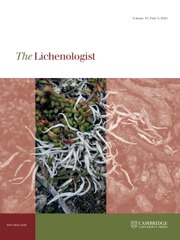No CrossRef data available.
Article contents
Umbilicaria ahtii – a new species of Umbilicaria subg. Papillophora from the vicinity of Helsinki with remarks on species of the Umbilicaria vellea group
Published online by Cambridge University Press: 12 December 2024
Abstract
Umbilicaria ahtii sp. nov. is described based on morphological and molecular characters. The new species resembles Umbilicaria vellea but the former has larger and submuriform ascospores, a darker lower surface, longer dark brown to black rhizinomorphs, and lacks thalloconidia directly on the lower surface and basal part of the rhizinomorphs. Phylogenetic analyses (ITS, mtLSU and RPB2) confirmed the distinctness of U. ahtii and indicated its sister relationship to U. meizospora. Umbilicaria ahtii is described from Finland and is currently known from several localities in Northern Europe (Svalbard, Norway, Finland, Kola Peninsula in Russia), Asia (Kodar Range, Siberia) and North America (Alaska). Within the U. vellea group, new molecular data confirmed U. koidzumii as a widespread, separate species sister to U. cinereorufescens. Diagnostic traits and variability of species, as well as their distribution patterns and nomenclature, are discussed.
- Type
- Standard Paper
- Information
- The Lichenologist , Volume 56 , Special Issue 5: A Special Issue dedicated to Professor Teuvo Ahti , September 2024 , pp. 201 - 218
- Copyright
- Copyright © The Author(s), 2024. Published by Cambridge University Press on behalf of the British Lichen Society



